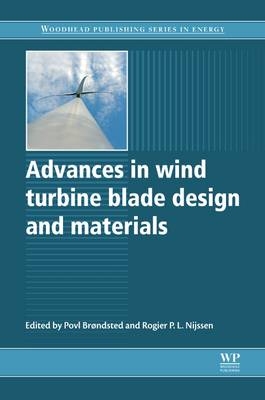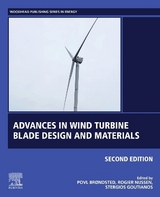
Advances in Wind Turbine Blade Design and Materials
Woodhead Publishing Ltd (Verlag)
978-0-85709-426-1 (ISBN)
- Titel erscheint in neuer Auflage
- Artikel merken
Wind energy is gaining critical ground in the area of renewable energy, with wind energy being predicted to provide up to 8% of the world’s consumption of electricity by 2021. Advances in wind turbine blade design and materials reviews the design and functionality of wind turbine rotor blades as well as the requirements and challenges for composite materials used in both current and future designs of wind turbine blades.
Part one outlines the challenges and developments in wind turbine blade design, including aerodynamic and aeroelastic design features, fatigue loads on wind turbine blades, and characteristics of wind turbine blade airfoils. Part two discusses the fatigue behavior of composite wind turbine blades, including the micromechanical modelling and fatigue life prediction of wind turbine blade composite materials, and the effects of resin and reinforcement variations on the fatigue resistance of wind turbine blades. The final part of the book describes advances in wind turbine blade materials, development and testing, including biobased composites, surface protection and coatings, structural performance testing and the design, manufacture and testing of small wind turbine blades.
Advances in wind turbine blade design and materials offers a comprehensive review of the recent advances and challenges encountered in wind turbine blade materials and design, and will provide an invaluable reference for researchers and innovators in the field of wind energy production, including materials scientists and engineers, wind turbine blade manufacturers and maintenance technicians, scientists, researchers and academics.
Prof. Povl Brøndsted leads a research program on composites and material mechanics at the Materials Research Department in the National Laboratory for Sustainable Energy at the Technical University of Denmark. Dr Rogier Nijssen is a research scientist at the Knowledge Centre Wind Turbine Materials and Constructions, The Netherlands. Their research has been both in research contracts and in public projects. Brøndsted and Nijssen have worked together in material research consortia such as the European Optimat and Upwind projects.
Contributor contact details
Woodhead Publishing Series in Energy
Introduction
Part I: Wind turbine blade design: challenges and developments
Chapter 1: Introduction to wind turbine blade design
Abstract:
1.1 Introduction
1.2 Design principles and failure mechanisms
1.3 Challenges and future trends
Chapter 2: Loads on wind turbine blades
Abstract:
2.1 Introduction
2.2 Types of load
2.3 Generation of loads
2.4 Fatigue and extreme loads
2.5 Design verification testing
2.6 Challenges and future trends
2.7 Sources of further information and advice
Chapter 3: Aerodynamic design of wind turbine rotors
Abstract:
3.1 Introduction
3.2 The blade element momentum (BEM) method
3.3 Important parameters in aerodynamic rotor design
3.4 Particular design parameters
3.5 An example of the rotor design process
3.6 Future trends
3.7 Sources of further information and advice
3.8 Acknowledgements
Chapter 4: Aerodynamic characteristics of wind turbine blade airfoils
Abstract:
4.1 Introduction
4.2 Computational methods
4.3 Desired characteristics
4.4 The effect of leading edge contamination (roughness) and Reynolds number
4.5 Airfoil testing
4.6 Airfoil characteristics at high angles of attack
4.7 Correction for centrifugal and Coriolis forces
4.8 Establishing data for blade design
4.9 Future trends
Chapter 5: Aeroelastic design of wind turbine blades
Abstract:
5.1 Introduction
5.2 Wind turbine blade aeroelasticity
5.3 Blade design
Conclusion
5.4 Complete turbine design
5.5 Challenges and future trends
5.6 Sources of further information and advice
Part II: Fatigue behaviour of composite wind turbine blades
Chapter 6: Fatigue as a design driver for composite wind turbine blades
Abstract:
6.1 Introduction
6.2 Materials in blades
6.3 Blade structure and components
6.4 Fundamentals of wind turbine blade fatigue
6.5 Research into wind turbine blade fatigue and its modelling
6.6 Future trends
6.7 Conclusion
Chapter 7: Effects of resin and reinforcement variations on fatigue resistance of wind turbine blades
Abstract:
7.1 Introduction
7.2 Effects of loading conditions for glass and carbon laminates
7.3 Tensile fatigue trends with laminate construction and fiber content for glass fiber laminates
7.4 Effects of resin and fabric structure on tensile fatigue resistance
7.5 Delamination and material transitions
7.6 Comparison of fatigue trends for blade materials
7.7 Conclusion
7.8 Future trends
7.9 Sources of further information and advice
7.10 Acknowledgments
Chapter 8: Fatigue life prediction of wind turbine blade composite materials
Abstract:
8.1 Introduction
8.2 Macroscopic failure theories
8.3 Strength and stiffness degradation fatigue theories
8.4 Fracture mechanics fatigue theories
8.5 Case study: Phenomenological fatigue life prediction
8.6 Future trends
Chapter 9: Micromechanical modelling of wind turbine blade materials
Abstract:
9.1 Introduction
9.2 Analytical models of the mechanical behaviour, strength and damage of fibre-reinforced composites: an overview
9.3 Unit cell modelling of fibre-reinforced composites
9.4 Three-dimensional modelling of composite degradation under tensile loading
9.5 Carbon fibre-reinforced composites: statistical and compressive loading effects
9.6 Hierarchical composites with nanoengineered matrix
9.7 Conclusions and future trends
9.8 Sources of further information and advice
9.9 Acknowledgements
Chapter 10: Probabilistic design of wind turbine blades
Abstract:
10.1 Introduction
10.2 Structural analysis models
10.3 Failure definition
10.4 Random variables
10.5 Probabilistic methods and models
10.6 Application examples and discussion of techniques
10.7 Challenges and future trends
10.8 Sources of further information and advice
Part III: Advances in wind turbine blade materials, development and testing
Chapter 11: Biobased composites: materials, properties and potential applications as wind turbine blade materials
Abstract:
11.1 Introduction
11.2 Biobased fibres and matrix materials
11.3 Biobased composites
11.4 Case study: Comparison between cellulose and glass fibre composites
11.5 Special considerations in the development and application of biobased composites
Chapter 12: Surface protection and coatings for wind turbine rotor blades
Abstract:
12.1 Introduction
12.2 Fundamentals of surface protection for wind turbine blades
12.3 Protection from blade icing, lightning and air traffic
12.4 Performance testing of protection layers: an introduction
12.5 Accelerated testing of the surface coatings of wind turbine blades in practice
12.6 Conclusions, challenges and future trends
Chapter 13: Design, manufacture and testing of small wind turbine blades
Abstract:
13.1 Introduction
13.2 Requirements for small wind turbine blades
13.3 Materials and manufacture
13.4 Blade testing
13.5 Installation and operation
13.6 Challenges and future trends
13.7 Acknowledgements
Chapter 14: Wind turbine blade structural performance testing
Abstract:
14.1 Introduction
14.2 Test program
14.3 Types of tests
14.4 Test loads
14.5 Test details
14.6 Conclusion
Index
| Reihe/Serie | Woodhead Publishing Series in Energy |
|---|---|
| Verlagsort | Cambridge |
| Sprache | englisch |
| Maße | 156 x 234 mm |
| Gewicht | 860 g |
| Themenwelt | Technik ► Elektrotechnik / Energietechnik |
| ISBN-10 | 0-85709-426-2 / 0857094262 |
| ISBN-13 | 978-0-85709-426-1 / 9780857094261 |
| Zustand | Neuware |
| Haben Sie eine Frage zum Produkt? |
aus dem Bereich



